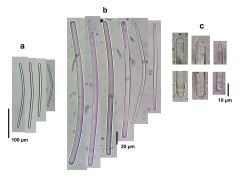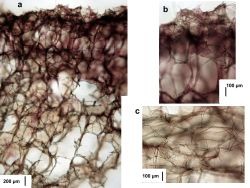yellow
branching
tough
Bahamas
Amphimedon? sp.-"branching morphotype"
Description: Sprawling, repent, thick branches, divided here and there; size reaching several tens of cm, with branches up to about 5 cm thick, with ends usually blunt. Surface smooth, even, with scattered oscules, usually on top, up to about 5 mm in diameter; excurrent canals visible inside oscules. Color golden yellow with purplish tones; subsurface color reddish brown (possibly from cyanobacteria), internal color cream. Consistency compressible, spongy, but slightly tough to cut or to tear. Skeleton as ascending paucispicular (2-4 spicules across) tracts variably enveloped by spongin, up to about 50 µm thick, separated some 125-250 µm, irregularly interconnected by single spicules or spicule tracts, forming a slightly rounded reticulation of 100-300 µm mesh diameter. At the surface, spicules are confusedly and more densely arranged in a paratengential fashion. Deeper in the choanosome, spicule fiber tracts are thicker (up to 80 µm), and there are many spicules strewn in confusion in between spaces of the main reticulation. Spicules are strongyles, slightly curved, sometimes a little sinuous, in an ample variety of sizes, 140-240 µm long and 4.3-7.5 µm wide; endings are from rounded, to slightly rugose to mammiform, being slightly asymmetric, one end slightly narrower than the other; developmental (thinner) stages tend to have narrower ends, slightly oxeote.
Notes: This is a deep reef species, living exposed. There are three distinct morphotypes (herein named "branching", "castle" and "tubular") of slightly toughly compressive to crumbling, yellow to tan sponges, that share a skeleton of slightly asymmetric strongyles arranged in ascending and interconnecting fiber tracts. We have tentatively called them Amphimedon? following the Systema Porifera (Hooper & van Soest, 2002) and in particular for the similarity in skeletal arrangement to A. viridis Duchassaing & Michelotti, 1864, also pictured here. We initially placed them with some hesitation within the genus Svenzea, for their similarity in coloration and texture to Svenzea? flava (Lehnert & van Soest, 1999) and Svenzea? tubulosa (Alcolado & Gotera, 1986)(both also pictured here). However, upon detailed examination, we found differences in spiculation (larger and more styloid in Svenzea?) and in skeletal arrangement (thicker and more loosely placed fiber tracts in Svenzea?). Spicules of these Amphimedon? species are similar to those of Neopetrosia dominicana (Pulitzer-Finali, 1986), also pictured here (spicule and tissue section composites only), and indeed, the image published from the type and its description as a subcylindrical fragment looks rather similar to our "branching morphotype", and the reported consistency (firmly resilient) also matches, although the color is described as brown. However, photos from tissue sections of the skeleton of the holotype (kindly provided by R.W.M. van Soest), show a dense and confused rounded reticulation of spicule tracts with little or no spongin. Whether the density of the skeleton is variable enough for our material to be conspecific to N. dominicana requires analysis of more material from other areas of the Caribbean. Another Caribbean sponge that needs to be compared to our material for having similar spiculation (strongyles 150-200 µm by 4-10 µm, with oxeote developmental stages) is Haliclona strongylophora Lehnert & van Soest, 1996), described from the deep reef zones of Jamaica, although it has a more unispicular, delicate skeleton.


